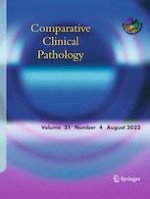Erschienen in:

17.06.2022 | Brief Communication
Reproductive hormonal profile in Eastern Pacific green turtles captured in-water
verfasst von:
Priscilla Howell, Marcela Suárez-Esquivel, Andrea Chaves, Didiher Chacón, Laura Castro-Ramírez, Kinndle Blanco-Peña
Erschienen in:
Comparative Clinical Pathology
|
Ausgabe 4/2022
Einloggen, um Zugang zu erhalten
Abstract
The Eastern Pacific green turtle (EPGT) has been differentiating from the green turtle and is currently considered a separate population. This study determined the values of reproductive hormones and total thyroxine of 56 resident foraging green turtles captured between 2012 and 2014 at Golfo Dulce, Costa Rica. All of them underwent a physical examination and were deemed as healthy individuals. The progesterone values were 0.31–2.723 ng/ml, estradiol 25.54–104.129 pg/ml, testosterone 1.94–228.97 ng/dl, and thyroxine 0.5–0.9 µg/dl. Since our population did not show sexual dimorphism, and the curved carapace length sizes did not match previous reports, turtles’ sex was determined based on high testosterone concentrations. Our results showed that 48 males (> 3 ng/dl), three females (< 2 ng/dl), and five yet undetermined individuals (2–3 ng/dl) were sampled. The green turtle populations at the Golfo Dulce seem to be formed by subpopulations at different stages of their reproductive cycle; among them could be males and females close to mating season, foraging females between seasons and sub-adults in their final developing habitat. The sampled population included 3 juveniles (one male and two not defined), 45 sub-adults (40 males, three females and one not determined), 7 adults (all males), and one undetermined individual (not sex determined either). The progesterone results indicated that none of the females were nesting; this might indicate that they nest far from the area. The information provided by this study is extremely valuable in the attempts to determine the health status for conservation programs of EPGT in the area.